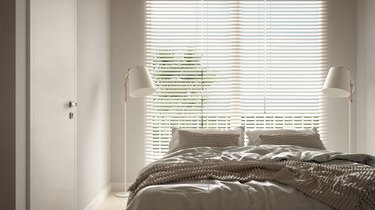
The direction — up or down — to close blind slats is a matter of personal preference, but if you want more privacy, tilt them up, with the rounded side facing out. With window blinds tilted up, passers-by can't see in: The convex side faces the window, creating less space through which to view. With the rounded side facing in and the blinds turned down, it's easier for prying eyes to see in the room at night, especially when it's lit from the inside.
Tip
Whether you turn your blinds up or down is totally up to you, although different positions offer different levels of privacy and energy efficiency.
Video of the Day
Turning Your Blinds Up
With the slightly rounded side of your blinds facing out and the concave side facing in, you have better light control in the room with the blinds up than if you turn the blinds to face down. With the blinds facing up, the inside appearance may not be as appealing as when they're down, but you reap greater privacy benefits. But because some faux wood blinds have only the top edge finished, the bottom, unfinished edge is hidden when they are in the turned-up position. Many people give a thumbs-up to blinds in the up position.
Video of the Day
Turning Your Blinds Down
Blinds with the top edge turned down and the rounded side facing the room offer a more aesthetically pleasing look, but what you gain in attractiveness, you give up in privacy. Blinds in this position also direct more heat and light into the center of the room. The rounded side facing the room also makes blinds appear softer, while creating larger gaps between the slats.
Aiming for Energy Efficiency
The position in which you set your window blinds also affects energy efficiency in the home. With the blinds tilted up and the rounded side facing out, the heat in the room moves toward the ceiling — a better position for blinds in summer. Keeping the blinds closed during summer's dog days helps to save energy and reduce energy bills.
Letting the Sun Shine In
In winter when the sun is out, open the blinds to bring sunlight into the room or set them so the rounded side faces the room to move warmer ceiling air closer to where it is needed. With the blinds facing up, outside sunlight and radiant energy are deflected skyward, and heat is directed away from the living spaces of the room.
Effects of Mounting Position
Blinds installed inside the window frame offer more warmth in the winter than when mounted on the exterior of the window frame. With the blinds inside the window and closed, a cushion of air is created between the blinds and the windows that adds a slight insulation factor to them. It keeps the colder air against the window. But you use less air conditioning when the blinds are installed on the exterior of the frame, because less solar energy penetrates into the room. In the end, both the mounting position and the slat position of your blinds depend on whether you live in a hot or cold climate, in the city, or in the suburbs or country.